In this edition of Paul’s Book Reviews: a disturbing memoir, a Cold War spy novel, untaught history, escapist thrillers, a political expose that doesn’t live up to the hype.
 “When Kiri added the graphic quote she claimed came from David—’Jeannine Bunds had the type of pussy that really hangs onto my dick’—Bill McCollum’s prim mouth went into spasm, and he immediately warned the TV audience who might be watching the C-SPAN broadcast to beware.”
“When Kiri added the graphic quote she claimed came from David—’Jeannine Bunds had the type of pussy that really hangs onto my dick’—Bill McCollum’s prim mouth went into spasm, and he immediately warned the TV audience who might be watching the C-SPAN broadcast to beware.”
A Place Called Waco: A Survivor’s Story
by David Thibodeau
![]()
I was asked by a publisher to read & review “A Place Called Waco: A Survivor’s Story.” I wondered why, given that David Thibodeau’s memoir was published in 1999. Now I see a TV mini-series titled “Waco” is set to air in January 2018. In an new afterword to the paperback edition, Thibodeau himself makes the tie-in clear, describing his excitement over meeting members of the cast and production crew.
The memoir is well-written, though windy and repetitive between the parts readers will come for: the sections about cult leader Koresh’s sexual infatuation with underaged girls; about the initial assault on the Mount Carmel compound by ATF agents; about the final siege and assault by the FBI and ATF 50 days later, about the fiery deaths of men, women, and children trapped in the compound with Koresh.
Thibodeau was an aspiring rock musician in Los Angeles when he fell in with members of a Christian rock band led by David Koresh. He gradually fell under Koresh’s sway, and after some dithering found himself a committed member of the cult, living full-time at the compound, yet not a member of Koresh’s inner circle, the “mighty men.”
I wish Thibodeau had made more of an effort to describe Koresh’s “teachings,” which from the bits he does reveal seem to be utter nonsense, as most Revelations-based apocalyptic cult preaching is. When it comes to Revelations and the End Times, I take my spiritual guidance from a fictional character, Lee Child’s Jack Reacher, who in one novel makes the commonsense observation that Revelations has been breathlessly promising the imminent arrival of Armageddon every day for 2,000 years.
Was Thibodeau, despite his half-hearted denials, an all-in member of the cult? There’s no doubt in this reader’s mind: with a straight face, Thibodeau recounts Koresh sidekick Steve describing his own background this way: “I went from England to Hawaii, changed into a heathen, lived a swinging life of booze and broads, partying with the fast crowd, the likes of Pat Boone and Clint Eastwood.” One feels one is inside the addled mind of Jack Chick, reading something like that. Cultists mimic normal humans, but there’s always a tell to let us know they’re from an alternate universe. Pat Boone?
Thibodeau is honest enough to question some of what he thought he knew about Koresh. He drops hints of Koresh’s perfidy here and there while simultaneously downplaying them, but my impression is that Thibodeau, afterward, came to see Koresh for what he obviously was, a charlatan who frightened willing believers with tales of mystical Seals, Horsemen of the Apocalypse, and the cleansing fires of God’s wrath; but mainly a creep who perved on pre-teen girls.
Even if your motivation for reading this memoir is hatred of the jack-booted thugs of the ATF and FBI and their murderous assaults on Koresh’s compound, you cannot avoid concluding that Koresh was guilty on many counts, from bedding ten- and eleven-year-old girls and cracking jokes with insiders about the tightness of their vaginas, to claiming God told him in a vision only he was allowed to have sex with Branch Davidian women (including the wives of married couples), to amassing an arsenal of semi-automatic and automatic weapons, to browbeating his band of believers into staying with him to the fiery end, to murder and worse.
Take this for what it’s worth: in the last chapter Thibodeau recounts congressional testimony from a 14-year-old girl who was 10 when Koresh first had sex with her, who went on to repeat Koresh’s crude remark about another pre-teen girl’s vagina. While Thibodeau is honest enough to include this damning information, he immediately backpedals by casting doubt upon the girl’s credibility. I wonder if he’s been following the news lately, and if he has, whether he thinks the women recounting their experiences with Harvey Weinstein and Roy Moore are lying as well. That is where I lost what little sympathy I had for David Thibodeau.
Of course there’s a solid link between the disastrous federal assaults on civilians at Ruby Ridge and Waco, and the growth of domestic right-wing militia terrorism, starting just two years after Waco with Timothy McVeigh’s bombing of the federal building in Oklahoma City, all the way to the Bundy militia today. Thibodeau forthrightly discusses the link in his memoir, detailing as well his own post-Waco involvement with the movement as a speaker at militia and survivalist rallies.
If you bring prejudices to the book you will leave with them intact, as I did. I guess I’m glad I read Thibodeau’s memoir. I didn’t learn much I didn’t already know, but I better understand my own conflicted view of federal authority now that I know the details of what the ATF and FBI did to women and children at Waco. Nevertheless, I remain repelled by cultists of any stripe, particularly end-times hucksters and the people who believe them. There is something wrong with their brains.
A final note: I read the Kindle edition, a digitized version of the original paperback plus the author’s more recent afterword. As is too often the case, the Kindle edition is loaded with formatting errors, but still readable.
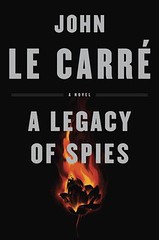 A Legacy of Spies
A Legacy of Spies
by John le Carré
![]()
From my review of an earlier le Carré novel, “A Delicate Truth”:
“Le Carré long ago moved on from the Cold War espionage era of his classic George Smiley character to the post-9/11, counter-terrorism, civilian contractor-dominated intelligence world of today, his later novels featuring mid-level actors in Britain’s foreign office and intelligence ministries. … You can feel le Carré’s anger with the direction covert intelligence-gathering has taken since the days when the Americans, led by Dick Cheney and his puppet George W. Bush, subverted and politicized the process, dragging Britain’s spy services down with them into a Keystone Kops frenzy of cherry-picking intelligence from favored sources, special rendition, torturing innocent and guilty suspects alike, and achieving nothing but failure after failure. Le Carré’s anger shines with a special intensity when he describes the yes-man atmosphere within Britain’s intelligence services today.”
I’ll say this, le Carré keeps us on our toes. His latest, “A Legacy of Spies,” returns to the Cold War era, populated (if in some cases at one or two removes) by his best-known characters, men like Peter Guillam and George Smiley. It expands on the tale originally told in le Carré’s most famous novel, “The Spy Who Came In from the Cold.”
I grew up in the Cold War; I served during the Cold War; I visited East Berlin multiple times during the Cold War. “The Spy Who Came In from the Cold” defined that era to readers of my generation. I don’t know about my fellow Baby Boomers, but I was terrified of it all; this is why I so admire the understated panache of le Carré’s spies as they fearlessly move about in Soviet-occupied territory, observing and being observed, playing targets and being played themselves, ever alert to the life-and-death stakes of the game they play. I love the attention le Carré lavishes on the Circus and its army of full- and part-time minders, technicians, and “housekeepers.” I hope such selfless servants of democracy exist in the real world, despite the depredations visited upon intelligence agencies during the Cheney-Bush-Blair era; le Carré almost convinces me they do.
“A Legacy of Spies” is entirely satisfying; the spymaster has lost none of his power.
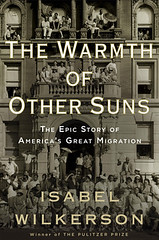 The Warmth of Other Suns: The Epic Story of America’s Great Migration
The Warmth of Other Suns: The Epic Story of America’s Great Migration
by Isabel Wilkerson
![]()
“The Warmth of Other Suns” examines the lives of three southern black Americans who moved north and west during the period of the Great Migration. The two men and one woman Isabel Wilkerson focuses on are good representatives of the 6 million who made up the whole: one follows the seacoast from Florida to New York City; one follows the well-worn path from Alabama and Mississippi to midwestern cities like Chicago and Detroit; one heads west to California, as so many from Louisiana and Texas did. The stories of these three people, along with the stories of their wives, husbands, and children, are told in separate and short biographical chapters.
Isabel Wilkerson’s book also recounts the overall history of the Great Migration. She fills in the gaps between biographical chapters with broad-brushed chapters about the South the migrants came from; vivid and chilling examples of the increasingly draconian Jim Crow laws southern blacks had to navigate in every aspect of their daily lives; the routes and patterns followed by black migrants from different parts of the former Confederacy; the nature and types of discrimination they faced in the North. I knew about the North and the historical patterns of segregation there; I had no appreciation of the scope and extent of the Jim Crow laws in the South. These chapters in particular opened my eyes and will stay with me for a long time.
I will note, as I see other reviewers have before me, that absolutely none of this was taught in school to anyone in my generation. I am willing to bet it isn’t taught now. There is thus great value in this book and others that examine the experience of black American citizens and their struggle. I salute Isabel Wilkerson. She made an impact on me.
“The Warmth of Other Suns” feels like one of those books challenged by parents and sometimes yanked from school libraries and reading lists by timid administrators looking to avoid confrontation. I searched for information on challenges and bans and found nothing. Perhaps, as I speculated above, this book is infrequently taught in middle and high school, if it is taught at all. That would be a shame.
Now for my only quibble:
There’s a pattern to most of the 30-minute automotive shows on cable TV. Each consists of four or five short segments, broken by commercials. During each segment, we see a preview of what’s to come in the next segment. When each new segment starts, we see flashbacks to the previous segment. Thus, minus commercials, 22 minutes of car show contains roughly 12 minutes of content.
There are no commercials in “The Warmth of Other Suns,” of course, but each biographical chapter previews the next, while each new chapter repeats details we already digested while reading earlier chapters. This is the repetitiveness so many reviewers complain of. It is unnecessary and I wish Isabel Wilkerson had cut out the previews and flashbacks … her great work would have been tighter and more impactful without constant repetition.
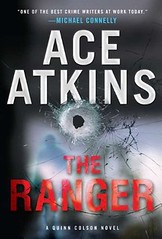 The Ranger (Quinn Colson #1)
The Ranger (Quinn Colson #1)
by Ace Atkins
![]()
There are many character-based thrillers out there, and everyone who reads them has his or her own favorites. I, for example, am reading the Jack Reacher novels in order, and normally that would be enough for me, but on the recommendation of a friend I picked up the first Quinn Colson novel by Ace Atkins, “The Ranger,” and quite liked it.
I didn’t think I would. The novel is set in rural Mississippi, and with one exception its characters are rural white Mississippians. I am hopelessly bound up in memories of Mississippi as a bastion of slavery, Jim Crow, race hatred, lynchings, illiteracy, and all-around backwardness. In short, I found Quinn Colson and his small circle of friends too good to be true, out of place among the toothless, livestock-fucking, pride-of-the-Aryan-Race denizens of the deepest pit of the Deep South. I’m not proud of my prejudices, but I’m not disowning them either. I know who Mississippians voted for.
Of course one has to suspend disbelief with any fictional righter of wrongs; Jack Reacher is an even more improbable character than Quinn Colson. Thrillers live and die by the quality of the writing; the ability of the author to capture the feel, smell, and taste of a place or time; the vividness of the characters; the craftsmanship of the plot. Ace Atkins nails it.
My friends continue to push their favorite thriller series on me; I must resist. Jack Reacher and now Quinn Colson are already eating into the time I have left to read all the great and promising books on my very long list.
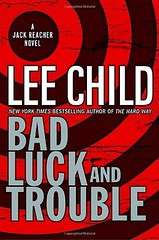 Bad Luck and Trouble by Lee Child |
 Nothing to Lose by Lee Child |
“Bad Luck and Trouble,” the 11th Jack Reacher novel, seems pared down, almost minimalistic. In an earlier review I said I liked Jack Reacher best when he’s in a military setting; in this one he works with former members of the Army special investigative unit he once ran. They’re civilians now, back together to find out how and why other members of that unit have been tortured and murdered, on the trail of the perpetrators, bent on vengeance, because by god you do not mess with special investigators.
Two women members of the team featured in previous novels, where they were fleshed out better; they’re more or less just there in this one, along with a male member who we don’t really get to know well at all: all three are foils for Reacher. The treatment of these characters isn’t all that different from the treatment of side characters in previous novels, but I noticed it more in this one. As I said: pared down & minimalistic.
“Nothing to Lose,” the 12th novel in the Jack Reacher series, is darker than previous ones, but it’s good Reacher.
Writing Jack Reacher reviews is a matter of diminishing returns: what more can one say about the character after the first dozen novels? In this novel, Reacher drifts into a pair of rural Colorado towns, Hope and Despair, as different as day and night, the one named Despair truly hellish.
You have to swallow a mighty big improbability pill to believe anything Lee Child tells you about the town of Despair and its zombified inhabitants, but the plot as always moves along smartly and Reacher stays in character. In this one, Reacher calls in no favors from former military or FBI associates; with the exception of Hope’s deputy policeman, the by now obligatory good-looking, strong-willed, intelligent woman sidekick, he unravels Despair’s complex, multi-layered, devilish mystery on his own.
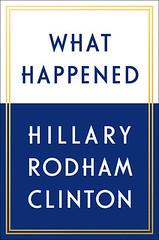 What Happened
What Happened
by Hillary Rodham Clinton
![]()
Did not finish: no rating.
I bought Hillary’s book after reading the same widely-publicized excerpts everyone did, the ones where she wrote frankly about significant campaign highs and lows and her reaction to the bewildering election of the losing candidate. Several chapters in, what I was reading reading instead were thanks to senior staff and campaign workers who struggled alongside her, individually singled out by name and fondly recalled, like some ultra-long version of an Oscars speech.
I began to flip ahead, looking for the chapter where she finally began to discuss “what happened.” Realizing flipping ahead meant I was losing interest, I moved Hillary’s book to my “reading episodically” stack and re-opened another from the same pile, David Foster Wallace’s “Infinite Jest.”
Now I have moved Hillary’s book from my “reading episodically” stack to the “did not finish” pile. A recent New Yorker contained a comprehensive review of “What Happened.” After reading it and other reviews, I decided to abandon ship. The New Yorker confirmed my own observation about the Oscar speech start, alerting potential readers (as I am doing here) that HRC’s discussion of the campaign (the presidential campaign and the media/FBI campaign against her) does not start until halfway in, and you’ve already read all the important parts anyway.